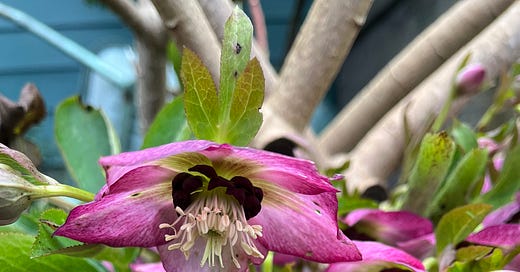It’s the last day of January, still dark, but harbingers of spring have arrived. At least here in Seattle. Today I heard birds singing like spring is in the air. So cheerful and talkative. The Hellebores are starting to show. So lovely and calming. I missed them so much in New Mexico. It was too cold for them there.
For those in colder climes, don’t forget Friluftsliv, translated from Norwegian to mean “Open Air Life”. Getting outdoors, even just a short time, helps us get through the cold and dark. Warm hat and gloves help.
It’s still Respiratory virus season. Mostly the big three, COVID, Influenza, and RSV. But also Pertussis or Whooping Cough. All are now vaccine preventable, or at least the vaccines help prevent serious illness.
The number of flu deaths vary each year, depending on the strain, range from 12,000 in 2011-12 to 52,000 in 2017-18. During 2020-21, during the first full winter of COVID, flu deaths were minimal, increasing to 4900 in 2021-22. Last winter and this winter, counts are rising again. Last winter (2022-23) an estimated 21,000. Expected to be higher this winter. The CDC has data showing influenza this year is often a mix of both A and B strains, making people sicker.
Wastewater testing shows the surge in infections, which hasn’t been helped by precaution fatigue. Weekly COVID deaths are way down from the peak, but still more than a thousand are dying weekly, 2000 at the beginning January. One reason is the low rates of vaccination for both flu and COVID, even though data shows they are effective in preventing serious illness. Only about 20% have gotten the COVID vaccine in the US and only about 45% received the flu vaccine. The other reason we still have high numbers of deaths is that many high risk people are not prescribed Paxlovid which can prevent serious illness.
JN1 is the most common COVID variant now. It has hit many of my friends and family lately. Symptoms are similar although some have more diarrhea and headache, still with sore throat, fatigue, and cough. Less common now is loss of smell.
Covid tests don’t work as well because it takes longer for the virus to peak. Transmissions are taking longer to occur too, even if it feels like more are getting infected. A study in Nature shows the rate of infection which goes up the longer th exposure, with more in household exposures because they are long. Short exposures are less risky now, which means you probably won’t catch it by having a brief conversation with someone who has it. As always, read the excellent post from Your Local Epidemiologist, Katelyn Jetelina. She explains it so well. Link is below.
Repeat a test in 2-3 days if you have symptoms and your first test was negative. If you only have one test to use, wait a day or two to perform the test to maximize your chance of getting a proper result. In the meantime, mask up, use ventilation or air filters in your house. Your loved ones will appreciate not being exposed to whatever virus is causing your symptoms!
I am hoping to write some other posts this week on topics like Long COVID, RSV, and other interests. Keep an eye out for those.
Stay safe, be skeptical, care for yourself.
And finally, my caveat is that this is my experience and my opinions, which are subject to change as more information is available. Thanks for reading.
Share this post if you know of others who may be interested. All links are listed at the bottom of this post. The New York Times articles have links that are gift links, allowing you to read the article for free.
A gentle reminder that I am now writing more regularly because I’ve committed to doing so by turning on Paid Subscriptions. Read about it here in this post: A Special Message. Most of my writing will remain free. Pay only if you wish to and are able to. The cost is $5/month, $50/year, $100 Founding Member, bonus is ability to post and other content. Think of it as tipping for a busker. Thanks to all who have paid already!
https://covid.cdc.gov/covid-data-tracker/#maps_deaths-rate-total
https://covid.cdc.gov/covid-data-tracker/#trends_weeklydeaths_select_00
https://www.seattletimes.com/seattle-news/health/holiday-gatherings-and-a-new-variant-have-driven-up-covid-cases-globally-the-un-health-agency-says/
https://www.cdc.gov/respiratory-viruses/whats-new/flu-and-JN.1-update-2024-01-22.html
https://www.seattletimes.com/seattle-news/health/respiratory-viruses-down-in-wa-but-still-circulating-at-high-levels/
https://www.seattletimes.com/nation-world/wastewater-tests-show-covid-infections-surging-but-pandemic-fatigue-limits-precautions/
https://www.cdc.gov/flu/about/burden/past-seasons.html
https://www.medpagetoday.com/infectiousdisease/covid19/108480
https://abcnews.go.com/Health/1500-americans-dying-covid-week/story
https://www.bbc.com/future/article/20240111-covid-19-how-does-its-symptoms-differ-from-flu
https://www.nature.com/articles/s41586-023-06952-2
https://www.seattletimes.com/nation-world/as-covid-rises-your-home-test-may-take-longer-to-show-a-positive-result/
https://www.seattletimes.com/seattle-news/health/how-to-make-the-most-of-your-at-home-covid-test/
https://www.seattletimes.com/life/outdoors/winter-in-seattle-how-locals-can-thrive-in-the-cold-with-friluftsliv/



